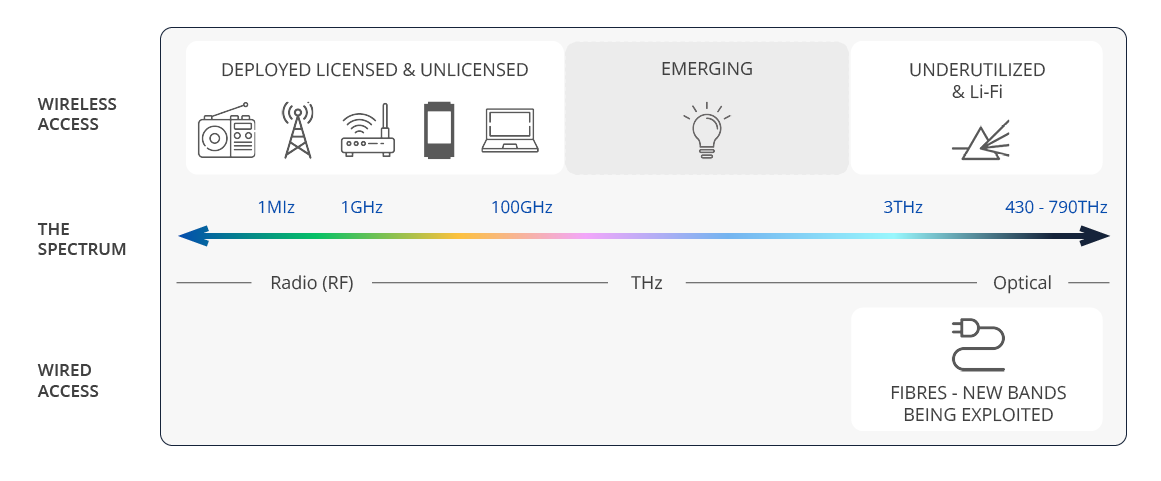HASC News
All communications rely on spectrum, the ‘frequency space’ needed to provide connectivity. As demand for this connectivity grows so does the search for new regions of the spectrum that can be used. All spectrum connectivity considers both the wireless spectrum that is well-known, and the spectrum that is available within fibres, understanding how to best use these together. This is the goal at HASC. In this article we take a deeper dive into what All Spectrum Connectivity is and where everything fits in.

Connectivity: The Invisible Thread Connecting Us All
From binge-watching your favourite boxset on Netflix to powering critical life-saving medical equipment, our world runs on effective connectivity. Most of our access to the internet is now wireless, so it’s worth starting with this part of the spectrum.
Wireless Technologies & The Spectrum
There are many ways our wireless communications are made possible, and all these use various parts of the spectrum, each with its own ‘rules of use.’
Licensed spectrum
In the UK, licensed spectrum frequencies are allocated to specific organisations via the communications regulator, Ofcom. Licences are typically used for services that need interference-free bandwidth or have the potential to cause interference to others.
- Exclusive rights to use certain frequency bands are issued to organisations such as mobile networks like 4G/5G/6G services. This includes, TV and radio stations and some fixed wireless service providers (wireless broadband).
- Licensed spectrum can provide reliable coverage as its use is limited to licensed users, but can be as expensive as it is regulated.
Unlicensed spectrum (license-exempt)
Certain bands are designated as licence-free and can be used if the equipment meets technical standards. Such bands are free to use but can be crowded and therefore prone to interference.
Common licence-exempt bands include
- 2.4 GHz and 5 GHz Bands: Used by Wi-Fi devices, Bluetooth, and other short-range communications
- 24GHz – Vehicle radar
- 27MHz – Citizens band (CB Radio)
- 863–865 MHz Band & 173.7–175.1 MHz Bands: Used by wireless microphones and audio equipment
Shared spectrum
Shared licences are used in sectors like agriculture, manufacturing, aviation, utilities, manufacturing, and rural broadband initiatives. Bands include
- 3.8–4.2 GHz Band: Available for local licensing, enabling businesses and other organisations to deploy private networks, such as industrial IoT applications
- 1.8 GHz and 2.3 GHz Bands: Shared use under special technical conditions that reduce the likelihood of interference with existing users
Each band has its own unique characteristics. Likewise, they all come with their own limitations. For example, some provide coverage, and some are free to use. For instance, your phone might use licensed 5G for speed and range but switch to Wi-Fi when indoors (or use both at once without you even noticing).
Wired Technologies
Put simply, ‘wired and wireless’ just refers to whether data is travelling down a physical cable or ‘through the air.’ Wired networks include:
- Copper cables (Ethernet) work by sending electrical signals
- Fibre-optic cables transmit data using optical signals, typically in the infrared range (~200 THz)
Wired networks provide the data backbone for communications, with wireless increasing being used ‘at the edge’ of the network to connect users to this backbone.
Both wired and wireless technologies are essential. How to best use both existing and emerging technologies together is the goal of HASC.
What is All Spectrum Connectivity?

From radio waves to light pulses – see where your everyday tech fits in the spectrum of connectivity.
So, what is all spectrum connectivity? All Spectrum Connectivity means using all the above technologies together intelligently, allowing devices and networks to switch dynamically or aggregate multiple bands for:
- Better coverage
- Increased capacity
- Enhanced reliability and speed
- Lower latency
All spectrum connectivity is much more than just Wi-Fi or mobile. It’s about intelligently combining all types of communication technology, from fibre to light to 5G. It aims to keep us all connected as networks become more complex and the spectrum becomes increasingly crowded.
The Hub in All-Spectrum Connectivity (HASC)
To tackle the challenges that exist in optimising all spectrum connectivity, HASC’s investigations span four main application areas:
- C1 Connectivity – demonstrating how different connectivity techniques can be integrated to optimise both wired and wireless communication systems
- C2 Adaptivity – explores adaptable networks that intelligently switch between wired and wireless technologies
- C3 Security – focusing on how to ensure that increasingly complex systems remain secure and resilient
- C0 Modelling – we are developing a holistic model of connectivity that unifies both wired and wireless communication systems across the spectrum
Here are some of the highlights from across the HASC project.
Virtual Fibre with Wireless Light Communication – University of Oxford
Most wireless traffic now happens indoors, with users relying heavily on Wi-Fi and demanding ever-higher data rates. Likewise, new applications such as virtual and augmented reality require mobile-friendly connectivity that allows users to move around but still enjoy a stable and uninterrupted experience.
This investigation explores an innovative approach using light – specifically, light transmitted via optical fibre – to provide high-speed wireless connectivity. A base station in the ceiling steers light to a mobile terminal within the room, enabling fast, low-latency communication, even as the user moves around.
This technology offers an efficient use of wired and wireless spectrum. It carries data over fibre (wired), through free-space using light (wireless), and then back into a wired connection. This creates a ‘virtual fibre’ link through the air.
Building on the success of the first-generation system, the team is now developing a second-generation version with improved real-time tracking. This system is bringing us closer to seamless, high-performance indoor connectivity. Learn more >
Wavelength Division Multiplexing Li-Fi at 100 Gbps – University of Cambridge
At the University of Cambridge, researchers are pushing the boundaries of wireless communication by pioneering Li-Fi. Li-Fi is a high-speed wireless technology that uses light instead of radio waves. In the latest experiments, they have built a system achieving ultra-fast data transmission speeds of 100 Gbps! This is around 100 times faster than typical home Wi-Fi or 5G.
One of the key motivations behind this work is the growing scarcity of radio frequency spectrum. The optical spectrum, by contrast, is vast, unregulated, and offers around 3,000 times more bandwidth, making it a valuable and untapped resource for future communications.
The aim is to build scalable, future-proof systems that can support next-generation applications. This includes everything from indoor connectivity to deep space communications, and even emerging technologies like holographic displays. Learn more >>
Ultra-low Latency Switched Fronthaul Networks – University of Bristol
Bristol’s research explores how artificial intelligence can revolutionise the way wireless networks are managed, particularly as we move towards future technologies like 6G. Traditionally, spectral resources (the radio frequencies used for wireless communication) are statically licensed to major operators. However, this often leads to inefficient use, with valuable bandwidth sitting idle.
To address this, researchers are investigating how AI, specifically deep reinforcement learning, can enable dynamic spectrum sharing. Dynamic spectrum sharing allocates resources in real time based on network demand. This approach could significantly improve performance, energy efficiency, and user experience. The team is also working within the Open RAN (Radio Access Network) ecosystem, developing more resilient and flexible network architectures that could replace current point-to-point links.
This shift from static to dynamic spectrum usage, paired with intelligent, AI-driven control promises to unlock more efficient, responsive, and sustainable wireless networks for the 6G era. Learn more >>
Rate Splitting Multiple Access – University of Imperial College
This experiment focuses on Rate-Splitting Multiple Access (RSMA) – a pioneering technique developed at Imperial College. It makes wireless networks not only more efficient but also smarter. As spectrum becomes an increasingly limited resource, they are investigating ways to maximise its use by enabling both communication and sensing capabilities within the same network.
This is especially valuable as we move towards 6G, where multifunctional and highly efficient wireless systems will be essential. The goal is to demonstrate that the theoretical advantages of RSMA translate into real performance gains when implemented on existing hardware. Imperial has already identified over 40 different use cases for RSMA, and this work has led to the first working prototype for a range of applications, from unicast to complex multi-group multicast transmissions.
By using rate-splitting to share limited spectrum more intelligently, this approach not only supports faster, more reliable communication but also opens the door to integrated features like sensing – laying the groundwork for the versatile networks of the future. Learn more >>
Final Thoughts – A Future Where Everything Connects
As the demand for faster, smarter, and more reliable wireless communication grows, the use of all available regions of the spectrum becomes more pressing.
Whether it’s using visible light to unlock ultra-high data rates, dynamically sharing underused radio frequencies with the help of AI or developing new techniques like rate-splitting to combine communication and sensing in the same spectrum, researchers are finding innovative new ways to make every part of the spectrum work harder and more efficiently.
By leveraging the full spectrum, from fibre to free space, from licensed radio bands to unregulated optical channels, HASC hopes to play our part in delivering a truly resilient and responsive communications ecosystem fit for the 6G era and beyond.
Want to stay involved? Keep an eye on our channels for updates, opportunities, and news from across the HASC community.
